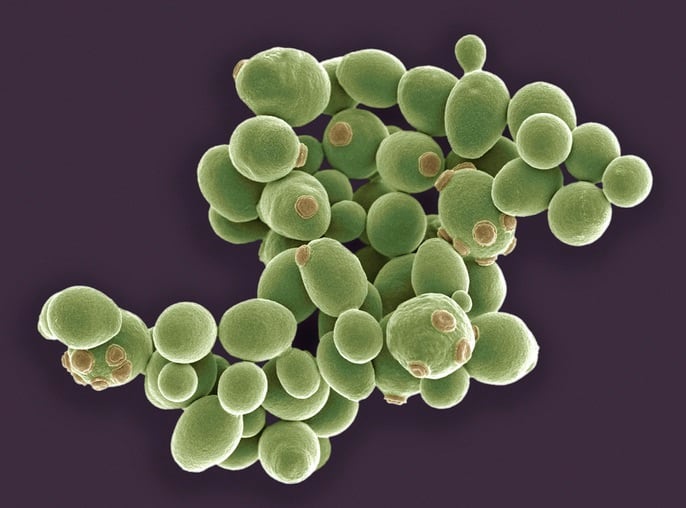l’hirondelle 1895 is a semi-dry, frozen yeast inspired by the century old bread making practice that treasures time as an essential ingredient.
The yeast’s long-fermentation process allows gasses to release slowly, providing the more complex flavors and textures of artisanal breads, while its modern format gives bakers greater control of the production process and can help them reduce wastage.
It also answers the demand for speeding up processes and reducing baking times, as well as meeting the changing tastes of consumers looking for healthier options.
Where trends start
Lesaffre is specifically targeting the 'trendsetting' Japanese bread industry with its new product.
The microorganism that influences our lives

Yeast is a single-celled microorganism related to mushrooms. About 1,500 species exist, but typically, only Saccharomyces cerevisiae (which means ‘sugar-eating fungi’) is used for bread making.
“Yeast is such an important and essential part of bread making,” said Lundgaard.
“It can be used for a variety of purposes, such as making bread dough rise, contributing to the flavor release and add to the sensory and nutritional qualities of bakery products.”
Yeast was first used by the Egyptians 5,000 years ago, but really came into its own when Louis Pasteur discovered the fermentation process in 1857. Pasteur demonstrated that the yeast cell could live with or without oxygen and was a key element in bread flavor and aroma.
“That discovery still influences our everyday life,” added Lundgaard.
With 165 years of experience in yeast and fermentation, Lesaffre has developed several types of yeast over the years, including the first-to-market instant dry yeast in 1973.
“We have been in the Japanese baking industry for 50 years – in fact, we are celebrating 50 years of partnership with our long-term partner Nichifutsu Shoji this year – and we’ve come to know that Japan simply has world-class artisanal bakers,” Joergen Lundgaard, MD of APAC, Lesaffre, told BakeryandSnacks.
“They treasure quality; they’re looking for new and innovative solutions; they’re looking for products that are convenient; and they’re also very interested in the slow-rising qualities that give the slow release of flavors.
“Japan is a market where trends start.”
He added the company sees significant growth potential in the region, based on the sheer size of the population, meaning that bread consumption is increasing.
Although consumption is still relatively low, compared to regions like North Africa or Europe, Lesaffre is making further investments in the region, including setting up a sensory analysis lab at its Baking Center in Singapore this year.
Return to bread
Lesaffre – which distributes its yeast products in Japan through Nichifutsu Shoji – is launching l’hirondelle 1895 at the height of consumer interest in artisanal breads.
According to Statista, the bread and bakery products segment in Japan is estimated to reach to $22.8bn in 2019, which equates to every Japanese consumer spending an average of $180 on bread and bakery products.
Euromonitor further forecasts that baked goods in Japan will grow at a CAGR of 1% to reach ¥2.4tr ($22bn) in 2022, as consumers continue to shift away from the traditional staple of rice in preference to more convenient sources, like breads, pastries and breakfast cereals.
However, when it comes to millennials, sensory appeal is more important than ever.
There is also a growing demand for European-style breads in Japan, adjusted to local tastes.
L’hirondelle (which Lundgaart told us is the French word for ‘swallow’, the bird used in the company’s logo) is suitable for use in recipes using up to 15% sugar such as artisan baguettes, European breads, croissants and shokupan, as well as for all baking processes such as sponge & dough and frozen dough.
The company claims it also give better crispiness and wheat aroma with less fermented flavor when compared to compressed yeast.
“Longer fermentation time allows the natural development of flavor in the dough, producing bread that is better for you,” said Jean-Louis Bouvier, technical bakery advisor at Lesaffre.
“This specific yeast profile also provides a very nice oven spring as well as a crumb texture that is more open and yellowish, which is very trendy now in France.”
l’hirondelle 1895 is available in 3.5kg bags and 400g tetra packs with a screw cap. It has a two-year shelf life at -18°C, meaning it can be stored and used as needed.
Lesaffre was founded in France in 1853 and today is a multinational company committed to working to better nourish and protect the planet. The company – which has an annual turnover of around €2bn – employs 10,000 people in nearly 80 subsidiaries based in 50 countries.
It also has 44 Baking Centres and five Culinary Centers around the world, working with industrial and craft bakers to cater to the diverse and evolving tastes of modern bread lovers.
It claims that one out of three loaves of bread in the world is made with Lesaffre yeast.



